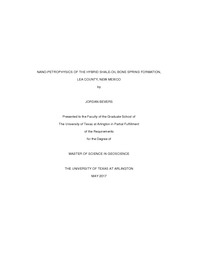
ATTENTION: The works hosted here are being migrated to a new repository that will consolidate resources, improve discoverability, and better show UTA's research impact on the global community. We will update authors as the migration progresses. Please see MavMatrix for more information.
Show simple item record
| dc.contributor.advisor | Hu, Qinhong | |
| dc.creator | Bevers, Jordan | |
| dc.date.accessioned | 2017-07-03T15:42:46Z | |
| dc.date.available | 2017-07-03T15:42:46Z | |
| dc.date.created | 2017-05 | |
| dc.date.issued | 2017-05-23 | |
| dc.date.submitted | May 2017 | |
| dc.identifier.uri | http://hdl.handle.net/10106/26825 | |
| dc.description.abstract | Despite the increased hydrocarbon production in hydraulically stimulated unconventional reservoirs, how fluid flows through the rock matrix in these reservoirs is still not well understood. It has been shown that much of the porosity in unconventional mudrocks is nanometer in size, making research challenging as analyzing these pores requires specialized methodologies. These pore networks affect fluid flow by their pore sizes, pore throats, and topology (pore connectivity). The Bone Spring Formation is one of the fastest growing unconventional plays in the world. It is a hybrid shale-oil system with high total organic carbon (TOC) source rocks juxtaposed against organic-lean reservoir layers such as sandstone and carbonate. However, there are very limited studies of nano-petrophysics (the interaction of fluids with porous media with a strong presence of nano-sized pore spaces) of organic-rich and organic-lean facies of Bone Spring Formation, which is the focus of this research. To achieve this objective, several core samples of both organic-rich and organic-lean facies in the Bone Spring Formation were taken from two nearby wells (both vertical and conventional wells with one being productive during 1984-2016 and the other dry).
The nanopetrohysics were investigated by mercury intrusion capillary pressure (MICP), contact angle (wettability) tests, spontaneous imbibition and vapor absorption. Pyrolysis was conducted to analyze maturity and TOC while X-ray diffraction (XRD) was carried out for determining mineral composition Porosity in the study samples varied from 0.3-3.2% with the majority of pore throats being 5-50 nm, which are likely organic or intraparticle types. Connectivity of the pore systems is very low for water (hydrophilic fluid) but high for n-decane (hydrophobic fluid). An integrated analysis of MICP, imbibition, wettability, and well logging results suggests that there is isolated porosity that is water-wet. No difference between the nano-petrophysics, in regards to porosity, pore-throat size, wettability, and permeability, of the different organic-rich and organic-lean facies in the two wells was observed. Our results from this area go against previous SEM studies which suggest TOC would be the main driver of porosity in the Bone Spring Formation but still supports that the reservoir intervals contain a higher percentage of non-organic hosted porosity. | |
| dc.format.mimetype | application/pdf | |
| dc.language.iso | en_US | |
| dc.subject | Nanopetrophysics | |
| dc.subject | Bone Spring | |
| dc.subject | Delaware Basin | |
| dc.subject | Permian Basin | |
| dc.subject | Unconventional | |
| dc.subject | Shale-oil | |
| dc.title | NANO-PETROPHYSICS OF THE HYBRID SHALE-OIL BONE SPRING FORMATION, LEA COUNTY, NEW MEXICO | |
| dc.type | Thesis | |
| dc.degree.department | Earth and Environmental Sciences | |
| dc.degree.name | Master of Science in Earth and Environmental Science | |
| dc.date.updated | 2017-07-03T15:43:49Z | |
| thesis.degree.department | Earth and Environmental Sciences | |
| thesis.degree.grantor | The University of Texas at Arlington | |
| thesis.degree.level | Masters | |
| thesis.degree.name | Master of Science in Earth and Environmental Science | |
| dc.type.material | text | |
| dc.creator.orcid | 0000-0001-8530-1379 | |
Files in this item
- Name:
- BEVERS-THESIS-2017.pdf
- Size:
- 3.185Mb
- Format:
- PDF
This item appears in the following Collection(s)
Show simple item record


